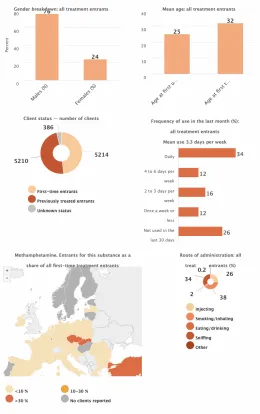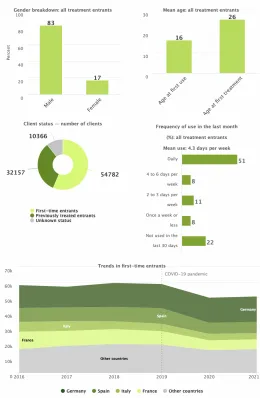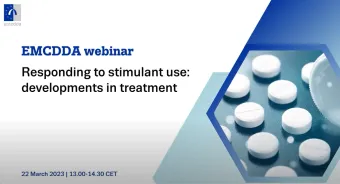Amphetamine users entering treatment in the EU (updated June 2021)

Description
Graphic shows characteristics and trends for apmhetmaine users entering treatment (EU-27), including trends.
This graphic is take from the European Drug Report 2021. Full source data and methods and definitions may be found in the Statistical Bulletin 2021.
Graphic source data is provided below for accessibility and reuse purposes.
Chatacteristics of amphetamine users entering treatment
Gender breakdown
| Gender | # | % |
|---|---|---|
| Females | 3215 | 25% |
| Males | 9699 | 75% |
Age
| Characteristic | Age |
|---|---|
| Mean age entering treatment | 31 |
| Mean age at first use | 21 |
Route of administration
| Route | Nummber | % |
|---|---|---|
| Injecting | 912 | 11% |
| Smoking/inhaling | 651 | 8% |
| Eating/drinking | 1359 | 16% |
| Sniffing | 5428 | 65% |
| Other | 37 | 1% |
Treatment status of client
| Number | % | Number (rounded) | |
|---|---|---|---|
| First-time entrants | 6277 | 47% | 6000 |
| Previously treated entrants | 4860 | 36% | 5000 |
| Unknown | 2354 | 17% | 2000 |
| Total | 13491 | 13000 |
Share of first time entrants for all drugs
| Austria | < 15% | |
|---|---|---|
| Belgium | < 15% | |
| Bulgaria | 15% - 30% | |
| Croatia | < 15% | |
| Cyprus | < 15% | |
| Czechia | < 15% | |
| Denmark | < 15% | |
| Estonia | < 15% | |
| Finland | 15% - 30% | |
| France | < 15% | |
| Germany | < 15% | |
| Greece | < 15% | |
| Hungary | < 15% | |
| Ireland | < 15% | |
| Italy | < 15% | |
| Latvia | 15% - 30% | |
| Lithuania | < 15% | |
| Luxembourg | < 15% | |
| Malta | < 15% | |
| Netherlands | < 15% | |
| Norway | < 15% | |
| Poland | 15% - 30% | |
| Portugal | < 15% | |
| Romania | < 15% | |
| Slovakia | < 15% | |
| Slovenia | < 15% | |
| Spain | < 15% | |
| Sweden | < 15% | |
| Turkey | < 15% |
Note. Apart from trends, data are for all treatment entrants with cocaine as primary drug. Trends in first-time entrants are based on 24 countries. Only countries with data for at least 8 of the 11 years are included in the trends graph. Missing values are interpolated from adjacent years. Due to changes in the flow of data at national level, data since 2014 for Italy are not comparable with earlier years.














